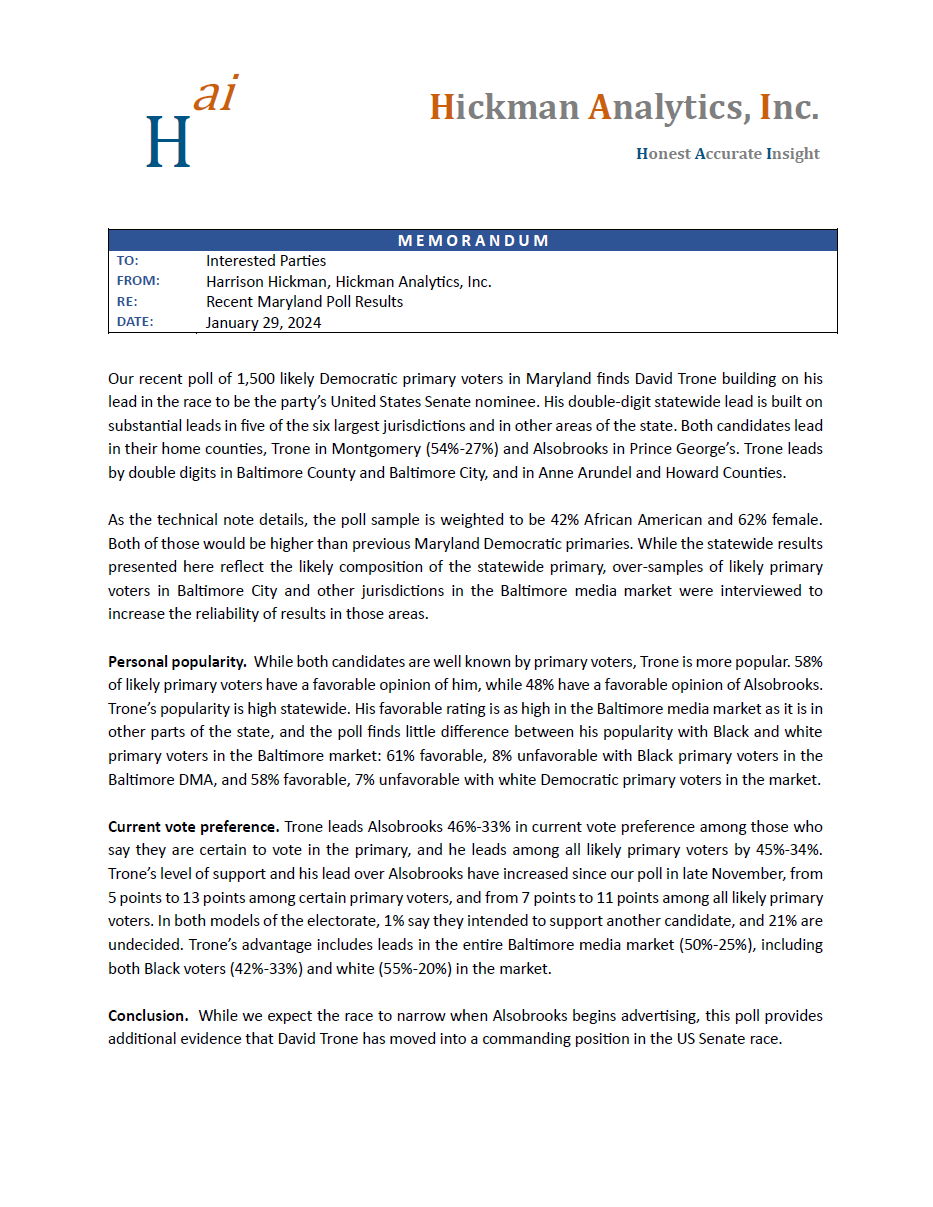By Adam Pagnucco.
Congressman David Trone, who is running for U.S. Senate, has released an internal polling memo claiming that he has a double digit lead over Prince George’s County Executive Angela Alsobrooks. His pollster, Harrison Hickman, recently surveyed 1,500 likely primary voters and found Trone with an edge of 46%-33% among those who say they are certain to vote and 45%-34% among the full sample.
Last month, Trone released an earlier polling memo from Hickman showing that he had a seven point lead at that time. I did a deep dive on that poll and wrote that its sample size suggested that it was close to a statistical tie and, since it was early and Alsobrooks was not yet on TV or in mail, it did not necessarily forecast the outcome of the race. Fast forward to now and Alsobrooks is still not on TV or in mail and she has shaken up most of her senior campaign team. Additionally, Trone’s margin is now outside the poll’s margin of error, which is 2.5 points.
All of this increases the pressure on Alsobrooks to initiate mass communications, which could close at least part of the apparent gap she has with Trone. Her next fundraising report, which will be coming out very soon, will make for interesting reading.
Hickman’s polling memo can be found here and is reprinted below.
*****
Memorandum
To: Interested Parties
From: Harrison Hickman, Hickman Analytics, Inc.
Re: Recent Maryland Poll Results
Date: January 29, 2024
Our recent poll of 1,500 likely Democratic primary voters in Maryland finds David Trone building on his lead in the race to be the party’s United States Senate nominee. His double-digit statewide lead is built on substantial leads in five of the six largest jurisdictions and in other areas of the state. Both candidates lead in their home counties, Trone in Montgomery (54%-27%) and Alsobrooks in Prince George’s. Trone leads by double digits in Baltimore County and Baltimore City, and in Anne Arundel and Howard Counties.
As the technical note details, the poll sample is weighted to be 42% African American and 62% female. Both of those would be higher than previous Maryland Democratic primaries. While the statewide results presented here reflect the likely composition of the statewide primary, over-samples of likely primary voters in Baltimore City and other jurisdictions in the Baltimore media market were interviewed to increase the reliability of results in those areas.
Personal popularity. While both candidates are well known by primary voters, Trone is more popular. 58% of likely primary voters have a favorable opinion of him, while 48% have a favorable opinion of Alsobrooks. Trone’s popularity is high statewide. His favorable rating is as high in the Baltimore media market as it is in other parts of the state, and the poll finds little difference between his popularity with Black and white primary voters in the Baltimore market: 61% favorable, 8% unfavorable with Black primary voters in the Baltimore DMA, and 58% favorable, 7% unfavorable with white Democratic primary voters in the market.
Current vote preference. Trone leads Alsobrooks 46%-33% in current vote preference among those who say they are certain to vote in the primary, and he leads among all likely primary voters by 45%-34%. Trone’s level of support and his lead over Alsobrooks have increased since our poll in late November, from 5 points to 13 points among certain primary voters, and from 7 points to 11 points among all likely primary voters. In both models of the electorate, 1% say they intended to support another candidate, and 21% are undecided. Trone’s advantage includes leads in the entire Baltimore media market (50%-25%), including both Black voters (42%-33%) and white (55%-20%) in the market.
Conclusion. While we expect the race to narrow when Alsobrooks begins advertising, this poll provides additional evidence that David Trone has moved into a commanding position in the US Senate race.
Technical note. This memo is based on a random sample poll of 1,500 likely Democratic primary voters interviewed by professional interviewers January 18-24, 2024. The sample was selected in a way to ensure that every Democratic voter in Maryland had an equal chance of being included. Respondents were interviewed via land lines and mobile devices. The design included over-samples of each jurisdiction in the Baltimore media market area of the state. The interviews were adjusted slightly to accurately reflect the known characteristics of the Maryland Democratic primary electorate. In this poll, 42% of the respondents are Black, and 50% are white. 62% of the respondents are female. All polls are subject to estimation errors related to interviewing a sample rather than all members of a universe. For a randomly selected sample of 1,500 primary voters, the results are within 2.5 percentage points, plus or minus, of the results one would obtain by interviewing every likely Democratic primary voter. The sampling errors are higher for subgroups.


